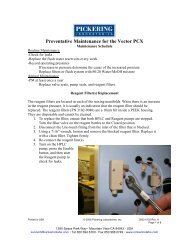to download our North American Product Catalog - Pickering ...
to download our North American Product Catalog - Pickering ...
to download our North American Product Catalog - Pickering ...
You also want an ePaper? Increase the reach of your titles
YUMPU automatically turns print PDFs into web optimized ePapers that Google loves.
METHOD ABSTRACTS105.2 / PARALYTIC SHELLFISH TOXINSANALYSIS OF DINOFLAGELATE DERIVED NEUROTOXINS IN BIVALVE MULLUSKS USINGHPLC POST-COLUMN FLUORESCENCE METHODThe paralytic shellsh <strong>to</strong>xins are a group of 18 secondary metabolites deposited in bivalve mollusks by dinoagelates. Dino-agelates blooms are seasonal, occurring during warm months. Since it is unpredictable whether an infestation will occur,the shellsh population should be regularly moni<strong>to</strong>red for <strong>to</strong>xins. Ingestion of contaminated shellsh can lead <strong>to</strong> paralyticshellsh poisoning; a life-threatening illness.Mouse bioassay is the ofcial method of AOAC International, but the drawbacks associated with this method have led <strong>to</strong>exploration of chemical methods. The most common HPLC post-column method is <strong>to</strong> oxidize the separated <strong>to</strong>xins underalkaline conditions <strong>to</strong> a uorescent compound. Sullivan et al. 1 used this method <strong>to</strong> determine the gonyau<strong>to</strong>xins 1-6 (GTX1-6), saxi<strong>to</strong>xin (STX) and neosaxi<strong>to</strong>xin (neoSTX) but not the N-sulfocarbamoyl-11-hydroxysulfate <strong>to</strong>xins (C1-C4). Oshima etal. 2, 3 modied this method <strong>to</strong> determine the 3 <strong>to</strong>xin groups separately using isocratic elution with 3 different mobile phases.Further improvement by Jeffery van de Riet et al. 4, 5 has led <strong>to</strong> a shorter analysis time <strong>to</strong> determine the 3 groups of <strong>to</strong>xinsusing step gradient and a switching valve. This method abstract describes the use of <strong>Pickering</strong> Labora<strong>to</strong>ries Pinnacle PCXpost-column derivatization system for the HPLC post-column determination of paralytic shell sh <strong>to</strong>xins.METHODEquipment:• LC with a Binary Pump• Fluorescence Detec<strong>to</strong>r• <strong>Pickering</strong> Labora<strong>to</strong>ries dual reagentPinnacle PCX post-column derivatization unit(1153-1061 – 120 V, 1153-1062 – 240 V)• Agilent Technologies Zorbax Bonus RP column,3.5 µm, 4.6 x 150 mm (863668-901)Reagents:• Heptane Sulfonate• Phosphoric Acid• Ammonium Hydroxide• Ace<strong>to</strong>nitrile• Periodic Acid• Sodium Hydroxide• Nitric AcidLC ConditionsSample Injection Volume: 10 µLFlow Rate: 0.8 mL/minMobile Phase:A. 11 mM heptane sulfonate, 5.5 mM phosphoric acid, adjusted<strong>to</strong> pH 7.1 with ammonium hydroxide.B. 11 mM heptane sulfonate, 16.5 mM phosphoric acid, 11.5 %ace<strong>to</strong>nitrile, adjusted <strong>to</strong> pH 7.1 with ammonium hydroxide.Post-column ConditionsColumn Temperature: 40 °CReac<strong>to</strong>r Volume: 1.0 mL (knitted)Reac<strong>to</strong>r Temperature: 85 °CReagent Flow Rate: 0.4 mL/minReagents:1. 100 mM phosphoric acid, 5 mM periodic acid,adjusted <strong>to</strong> pH 7.8 with 5 M sodium hydroxide2. 0.75 M nitric acidDetection: Fluorometer ex: 330 nm, em: 390 nm



